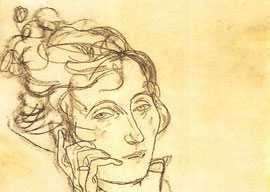
October 19, 2013

Edith Schiele, 1918
I would have thought it a fine sketch, for of course Schiele was an accomplished artist. But my assessment of the woman he portrayed might have been very different: I should have thought her world-weary in the arrogant way that intelligent people, for fear of appearing naïve, sometimes affect. I would have feared and mistrusted her.
According to our modern sensibility, Schiele’s act of drawing his wife on her deathbed (assuming he knew that it was such) would seem almost callous, the turning of death into some kind of spectacle for the advantage of his art. This impression might be strengthened by the fact that the sketch is signed and dated, as though Schiele (whose last work it was) was anxious not so much to commemorate his wife but himself and was aware that one day everything by his hand would be of great monetary value.
In their explanatory notes, the exhibition’s curators said that the deathbed portrait was a manifestation of a Viennese “fascination” with death (both Beethoven’s and Mahler’s death masks were also exhibited). The implication was that this “fascination” was in some way morbid or neurotic.
This persuaded me that the one thing we refuse to do in these supposedly multicultural times is to try to see the world, including ourselves, through the eyes of others, either in time or in space. Might it not be that those others would consider our own determination to push aside or avoid personal confrontation with death”which is, after all, still the inevitable dénouement of human life, technical progress notwithstanding”morbid and neurotic? Is our avoidance of all contact with death (except on video games) not a pretense that we shall live forever, that death is an aberration that we shall not fall into thanks to our healthy diet, our full health insurance, and our thirty minutes” exercise a day, and that, while some people no doubt continue to die, it is really by their own fault or at their own insistence? Is not our revulsion from deathbed portraits”an old genre, after all, and by no means confined to the fin de siècle Viennese”more indicative that we wish to ignore the fundamental condition of our existence, even at the cost of forgetting our loved ones, so that we can get on with the business of life, which is to amuse ourselves?
In short, is it not an indication of shallowness and egotism?